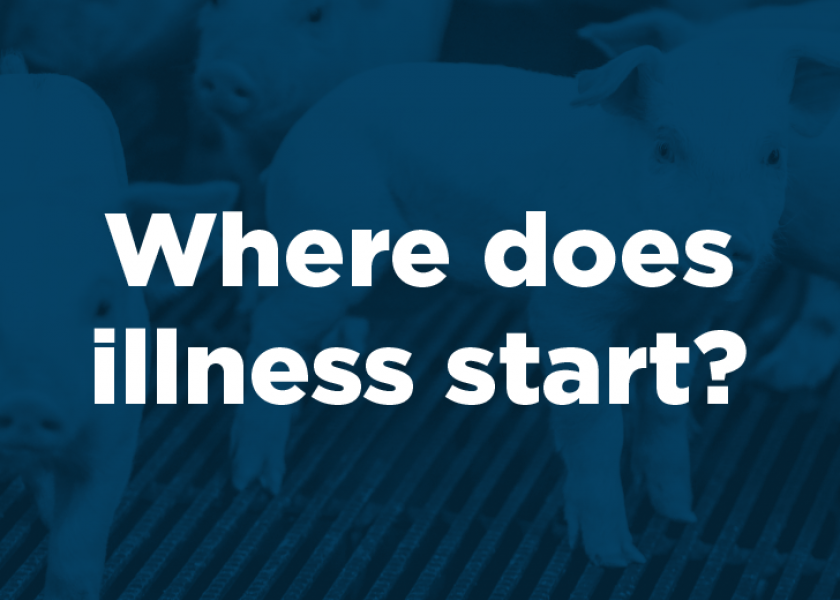Industry Considerations: Microbiome Connections

Maybe not where you think...
A nursery pig has been diagnosed with porcine reproductive and respiratory syndrome (PRRS). Another has severe diarrhea. It might be assumed that infection in the former started in the lungs, and the digestive system in the latter.
But what if we’re not 100% right?
There’s a good chance a microbial cocktail churning within those piglets is where the problems began. While that in itself can be difficult to diagnose, complicating matters is the possibility that a group of microorganisms from one end of a pig has set in motion an infection at the other end.

All living creatures, including humans, have within them microbiomes. We’ve known about microbes and their activity since 1676, when Dutch scientist Antonie van Leeuwenhoek first observed them. However, scientific advances in van Leeuwenhoek’s discovery haven’t come swiftly in the succeeding 344 years.
Not until a decade or so ago did scientists begin to unlock the mystery of microbiomes and the role they play in disease. One particularly important discovery is how microbiomes communicate with each other, including the two-way information sharing between microbiomes in the intestinal tract and lungs. This “gut-lung axis” is believed to be pivotal in the origin and treatment of many viral illnesses in animals and people.
Much of what we know about the gut-lung axis comes from human health research. Hundreds of beneficial bacterial, fungal and virus species reside within the gut and lung microbiomes. These species engage in “crosstalk” with each other, with the immune systems of their own gut and lung families, and with the species and immune systems of their gut-lung counterparts. The crosstalk connections are every bit as sophisticated as a city street map.
The chemical communiqués these microscopic messengers send along the crosstalk pathways trigger immune systems to fight pathogens and other unfriendly microorganisms. When the immune system is working as it should, it snaps into action to attack pathogenic invaders, often without the host even being aware a biological battle is being waged.
When the pig’s immune system is not able to ward off infection and the treatment provided by the animal’s caretaker is ineffective, it can leave animals less productive, or even end in death.
Young pigs are especially vulnerable. During the critical period between farrowing and weaning a piglet’s immune system is underdeveloped and an easy target for viruses. Herd health often determines whether a piglet makes it to immune system maturity unscathed or a harmful pathogen within the herd makes its way into the juvenile.
Prevention, sows and more questions than answers
Much has been written and said about piglet disease prevention and mitigation, with a heavy emphasis being on antibody transfer from sows to babies through the mother’s colostrum, and treatment options for PRRS, E. coli and other bacterial infections. Until recently little in animal science journals and the agricultural press has addressed microbiomes and how they engage in the gut and lungs.
There remain more questions than answers, but research into the gut-lung axis may be getting closer to painting a full picture of what goes on inside a piglet. A few examples:
- Research led by Tim J. Schuijt of the University of Amsterdam found that increased gut microbial diversity is associated with lower mortality, fewer lung lesions and an enhanced ability of alveolar macrophage phagocytes after infection with Streptococcus pneumonia, a common culprit in lung, ear, sinus, brain and spinal cord infections.
- Pig-specific research led by Kyle M. Schachtschneider of the University of Illinois found as gut microbial diversity increased, clinical signs of Mycoplasma hyopneumoniae infection decreased, as did lung lesions post-infection.
- A team of scientists from China’s Shanxi Agricultural University, Texas A&M University and the University of Edinburgh, U.K., studied PRRS and its effect on swine intestines. Measuring porcine reproductive and respiratory syndrome virus (PRRSv) replication in pig tissue they noted, among other things, evidence of PRRSv inflammation in the jejunum, one of three sections that make up the small intestine. Furthermore, piglets in the PRRSv study group displayed emaciation, declining food intake, abdominal breathing, wheezing, coughing and gastroenteritis-like symptoms, including diarrhea.
Megan C. Niederwerder, DVM and assistant professor in Kansas State University’s College of Veterinary Medicine, and a leading authority on swine microbiomes, says there is still much to learn about the gut-lung axis. In the February 2017 issue of Veterinary Microbiology, Niederwerder wrote:
“Although initial reports describing the close relationship between the gastrointestinal and respiratory mucosal immune systems were published decades ago, there is still vast amounts of knowledge necessary to understand how these two systems function together in immunity.”
“Much of the research in the field of the gut-lung axis has focused on diseases considered noninfectious, such as asthma, allergies, idiopathic pneumonia syndrome, and chronic obstructive pulmonary disease. However, increasing evidence has emerged on the relationship between the microbiome and infectious diseases of the respiratory tract. Bacterial, viral, and even fungal infections of the pulmonary system have been shown to have associations with microbiome composition or diversity.
“As pneumonia continues to be a leading cause of morbidities and mortalities in humans and swine, the microbiome provides a new avenue for case management and an alternative approach for disease control.”
Along with research to better understand gut-lung microbiomes and disease transmission there is work being done to improve gut health of sows and their young so they are less susceptible to pathogens. Swine diets are at the top of that list.
By adjusting diets to include certain feed additives, gut microbial balance associated with piglet weaning could potentially be restored and strengthened.
In summary, microbial activity within a pig’s gut can be the source of infections in its lungs, and vice versa. The good bacteria, fungi and viruses that reside within the gut and lung microbiomes and immune systems of each communicate with the other to trigger immune responses when harmful pathogens attack. While we still don’t completely understand how the relationships between microbiomes work, ongoing research indicates the health of this “gut-lung axis” is especially critical in the farrowing to weaning period of a pig’s life.

Elanco and the diagonal bar logo are trademarks of Elanco or its affiliates.
©2022 Elanco or its affiliates.
EM-US-22-0156 | 879376927








